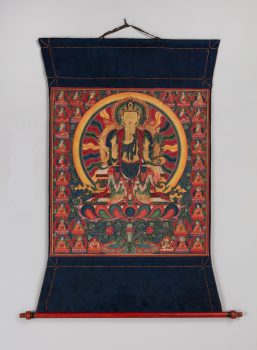Tibet
ca. second quarter of 15th century


Tibet
ca. second quarter of 15th century


This luminous painting of the Future Buddha, Maitreya, shows him sitting on his celestial throne in Tushita heaven radiating light. The Future Buddha sits with his legs extended as if poised and ready to descend to earth and take up his ministry as the buddha of the next eon. He is adorned with the princely jewels and garb of a bodhisattva, having not yet taken up his future role as the next buddha, when he would be depicted in monk’s robes like the buddha of our current age, Shakyamuni. In his left hand Maitreya holds the stem of a Nagakesara blossom carrying a flask, his distinctive identifying attribute. His throne is supported by a lotus emerging from a fenced pond, the branches of which form the subtle scroll that frames all of the secondary figures. The extensive teaching lineage it contains at the sides indicates that this painting refers to the Five Treatises of Maitreya, five commentaries on Buddha Shakyamuni’s teachings attributed to Maitreya. Exemplary for fifteenth-century art, this painting continues organizational features from earlier styles but places the figures against a uniform dark-blue sky background with stylized clouds. Typical for the period are the large leaves and flowers branching off the scrolling lotus throughout the painting. Thus, although there is no landscape as such, the composition does create a sense of space around the figures that is absent in earlier paintings. Compared with the nearly contemporaneous Gyantse murals, the decorations here are restrained and exemplify the stylistic possibilities shortly before the landscape revolution of the mid-fifteenth century.
In Buddhism time is perceived as relative, dynamic, and conceptual. This outlook highlights important principles of interdependence within Buddhist philosophy.
The passing down of authentic Buddhist teachings from a teacher to a disciple or student, often in the form of a text in a ritualistic context.
The transmission of teachings from one generation to the next, from teacher to student, traced all the way back to the Buddha without interruption. A complete lineage is essential in Tantric Buddhist practices as it makes the blessings of the teaching more powerful.
An awakened being who understands the true nature of reality and is free from the cycle of birth, death, and rebirth. While there are many buddhas, Siddhartha Gautama is the historical Buddha, whose teachings became the foundation of Buddhism.
Today, Tibetans primarily inhabit the Tibetan Plateau, situated between the Himalayan mountain range and the Indian subcontinent to the west, Chinese cultural regions to the east, and Mongolian cultural regions to the northeast. During the 7th to 9th century, Tibetan rulers expanded their empire across Central Asia, and established Buddhism as the state religion.
Get the latest news and stories from the Rubin, plus occasional information on how to support our work.